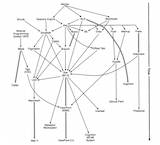Xerox Star
Contemporary graphical user interfaces on commercial desktop computers are very similar conceptually to the one of the Xerox Star computer, which was designed at the PARC during the 1970s. The graphical user interface in combination with the mouse and the keyboard are a very effective way to work with word processors, spreadsheets, and image editing applications. It is no coincidence that the core business of the mother company Xerox has been with publishing houses, which have been extensively studied by the researchers at PARC, who created the Star computer, as a solution to desktop publishing. Therefore, the study of the Xerox Star computer provides a deeper understanding of the first mainstream user interface, as well as an explanation of the respective design choices. Then, we realize that if Xerox had a different core business, then the desktop computer might have not been realized or might have a different form and utility.
Although the main components of the graphical user interface have been around from previous research and commercial efforts (e.g., mouse, digital word processing, object manipulation), Xerox Star was the first integrated demonstration of an accessible user interaction paradigm that is known as the desktop metaphor. Xerox Star was created through a human-centered design process that considered the workflows of print publishers, which was concerned with word processing and book production. For this purpose, Xerox PARC researchers observed the workflow of documents in an office. In this way, they recognized an unfulfilled need for straightforward document editing, storage, and distribution. These needs are particular to the business of print publishers, but there are also possible generalizations that concern any type of multimedia documents for other purposes, which the desktop metaphor has been able to accommodate through the years.
The modern desktop graphical user interface is the result of a long-term effort that integrated several interaction archetypes into a coherent user interface. It is usually referred to as the Windows Icons Menus Pointer (WIMP) interaction model, which refers to the four basic interaction elements. Windows stand for documents, icons stand for application, documents, and folders, while menus provide actions on icons or on document contents. The pointer is usually controlled by the mouse and enables the selection of and the navigation through windows, icons, and menus. The mouse is not the only option, since the pointer can also be controlled with a similar indirect input device such as the touchpad or a pen, or even directly with touch or a pen. The desktop metaphor and the direct manipulation of the items in the WIMP model are the main unifying concepts in this class of user interfaces. Although we have defined a few important archetypes, there also might be some variations in style or in the details of the implementation across the offerings of different brands, such as Linux, MacOS, and Windows.
In summary, the desktop metaphor is an interaction paradigm that has resulted from a human-centered design process that considered the needs of specific user group and took advantage of available technologies. The user group was the staff of print publishers, while the available state-of-the-art technologies at that time were several pointing devices and graphical displays. The mouse as a pointing device played an important role because it is very efficient and enables the manipulation of abstract information elements on a computer screen. The information elements could be text, or pixels in an image. The decoupling of the input device from the type of information has been instrumental, because previous efforts had to restrict user interfaces in particular information domains. For example, a keyboard was used to manipulate text on a text display. The manipulation of abstract information elements enabled the creation of a general purpose computer for user application of different domains. In this way, the Xerox Star contribution is larger than the invention of desktop computing, because it stands as case of the combined power of method, archetypes, and tools for transforming human activities through new interaction paradigms.


